Second only to Rome, Milan is the city to visit on your Italian trip. The city’s popularity has recently surpassed both Venice and Florence, and both Italians and tourists continue to flock to this city for many reasons. Italians will tell you that this industrial city is the place to go to work, as it is undoubtedly the wealthiest and busiest Italian city. While it may not be a quaint Tuscan village, a picture tourists often associate with Italy, Milan is home to some of the most unique, beautiful, historical, and modern architecture in this part of the world. It is also very rich in museums, art exhibitions, and monuments that you must see on your trip here!
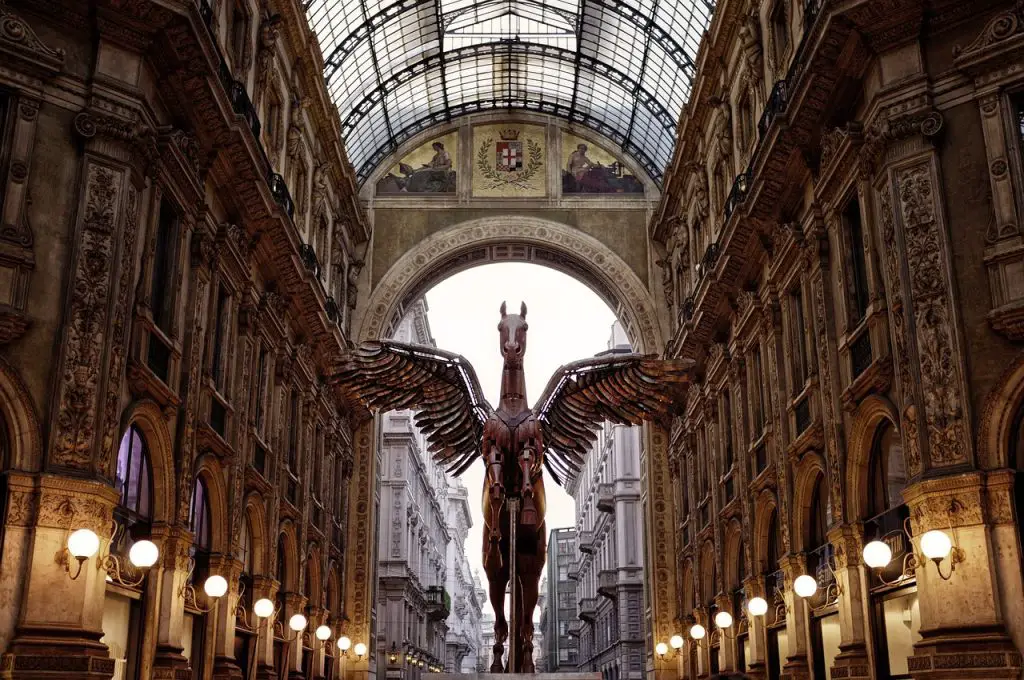
Everyone also associates this city with soccer and fashion and for good reasons. It has long been among the best cities to visit to see the most recent runways, models, and photographers in its streets, and many people come here to participate in the Milan Fashion Week or to do some high-quality shopping. Football lovers associate this town with the two most popular Italian football clubs, AC Milan and Inter Milan, both of which have a strong fan base and a rich history of success.
Others visit Milan since they know that Milan has its share of the most delicious food on planet Earth. In all fairness, there is something for everyone in Milan: history buffs, art lovers, fashionistas, foodies, and even soccer enthusiasts will find something interesting to see and do in Milan. Since there are a lot of sightseeing and interesting activities you can take part in during your visit, we highly recommend spending at least five days here. So, here is the list of the must-see spots and activities to do in those five days as you visit Milan.
Duomo di Milano
Milan Cathedral proudly stands at the heart of Milan. It is the third-largest church in the world and the largest church in the whole of Italy. An unmissable sight on your visit to Milan, the Duomo, its surrounding Piazza, and the museum simply have to have a spot in your itinerary. The construction of this marvelous structure began in 1386. It took almost six centuries for it to become the breathtaking cathedral that shows up on the postcards of Milano. The actual date that officially marked the end of the construction process was 1965.
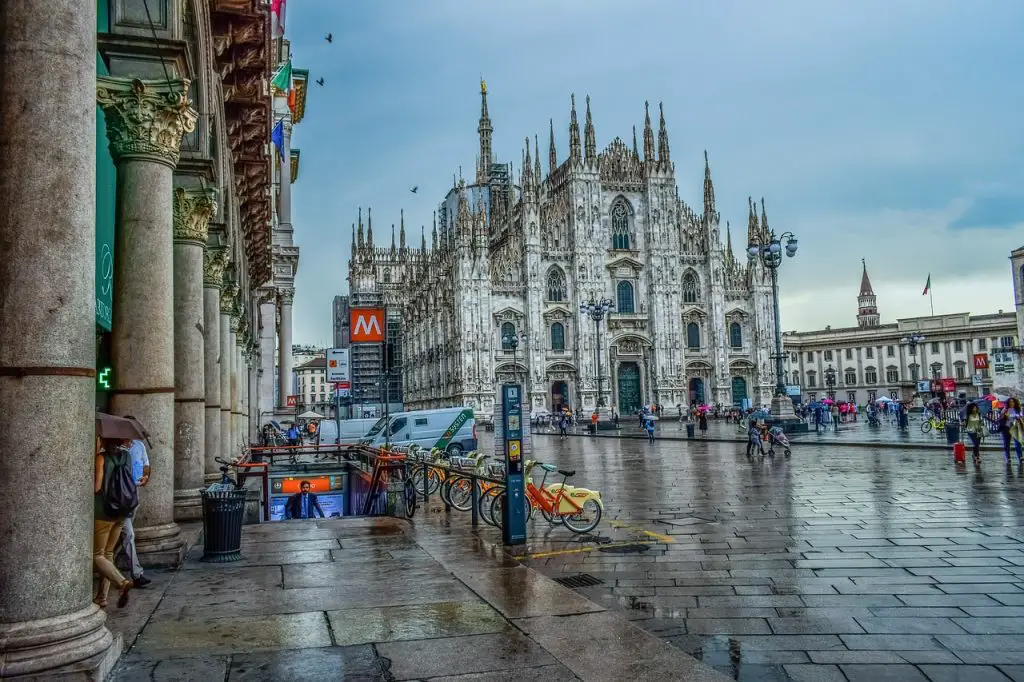
After several hundred years in construction and almost eighty different architects and engineers manning the project, it is quite difficult to find a single word to describe the Milan Cathedral. The combination of different architectural styles, both contrasting and complementing each other, leaves a memorable impression. The details and sculptures on the exterior of the cathedral allow us to marvel at the skills and craftsmanship of the artists involved, while the towering spires and sheer size make it an unmissable sight in its grandeur.
Aesthetically, the cathedral is both admired and disfavored by those who find themselves competent to judge, yet no one argues that it is truly a sight to remember. Many famous writers were also inspired by the Duomo and have included it in their manuscripts. Mark Twain, Oscar Wilde, and Henry James were all eager to write about it, and we are sure you won’t be able to resist taking many photos and talking about your visit to Duomo for years to come.
Piazza del Duomo
Italy is renowned for its piazzas, and Milan doesn’t hold back on them either. The main piazza of Milan is definitely the Cathedral Square, or Piazza del Duomo. Named after the cathedral, it stands right in the center of the city. Not only does it mark the center in a literal, geographical sense, but it is also the center in a cultural, artistic, and commercial sense. It includes some of the most important buildings in the city, the cathedral being just one of them.
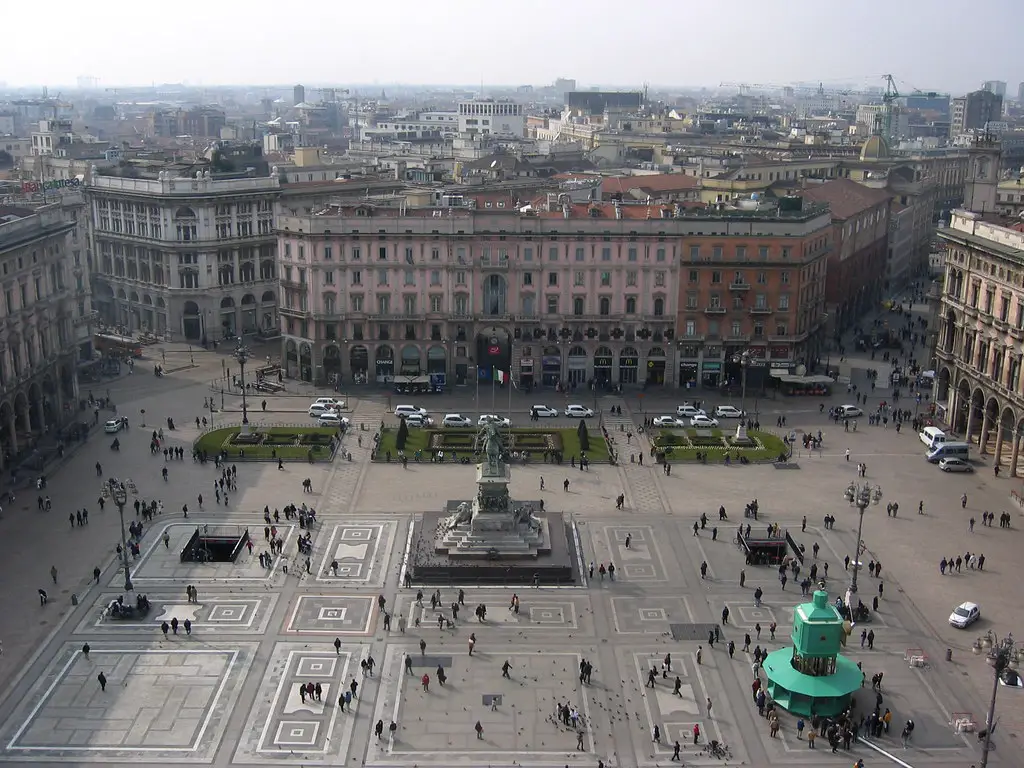
The original idea for this piazza stems from way back in 1330. However, a similar fate befell the Duomo and Piazza. The latter was also finished centuries later, in 1896, when the statue of King Victor Emmanuel II of Italy was posted in its center. Even if you don’t make a spot for the piazza in your itinerary for its unique beauty, you will cross it on your way to some of the most popular sightseeing spots, so it is definitely an unmissable spot in Milan.
Duomo rooftops
If you decide to visit Duomo, don’t miss the opportunity to take a stroll on Duomo’s rooftop! The rooftop of this remarkable structure is open to tourists and offers an exclusive view of some of the most exquisite sculptures and statues that you cannot see from below. Needless to say, the aerial view of Milan from the rooftop is breathtaking, too. It is certainly a sight to remember, so don’t get too lost in the beautiful exterior and interior of the Milan cathedral to forget to visit the rooftop as well!
Museo del Duomo di Milano
Experts will recommend visiting the Duomo Museum before visiting the cathedral, as it is the perfect spot to admire the beauty of the Duomo, which otherwise might get lost among the grandeur of the building itself. In this museum, you will be able to admire the aspects of Duomo from up close, including its sculptures and works of art. A visit to the museum first will provide you with more information and a deeper understanding of how the six centuries of construction and the following wars impacted the Duomo.
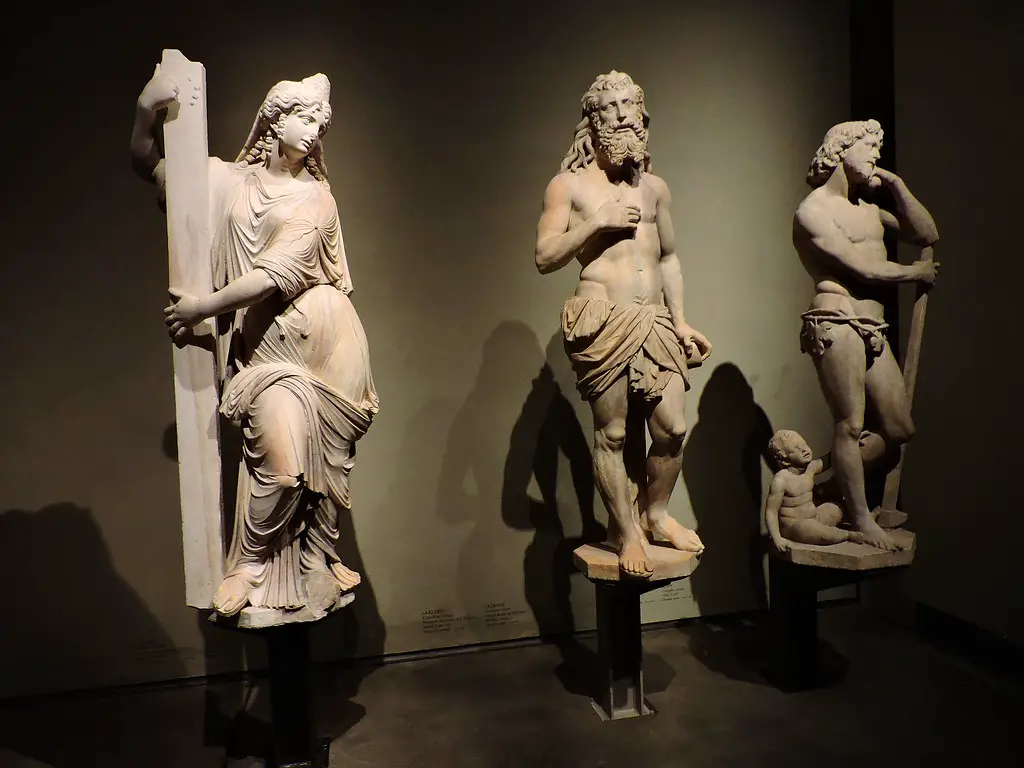
During your visit, you can explore and admire not only the paintings and sculptures of Duomo but also the stained glass windows, the architectural models, and the statues that once graced the cathedral. Most of these were part of the cathedral’s history at the time but were ultimately moved to the museum as it was easier to perform necessary reconstructions there. At the time of the wars that plagued Europe, these pieces were also much safer in the museum.
For others, safety concerns proper conservation to this day, so they joined others at the museum. We believe that visiting Duomo with this knowledge and newfound admiration for the master craftsmen that created the marvelous pieces that once graced Duomo would significantly enrich your experience of visiting the cathedral itself.
Galleria Vittorio Emanuele II
Back in the 1860s, Vittorio Emanuele II, the first king of Italy, decided to modernize the city center. In 1865, he placed the first stone of the now-Gallery of Vittorio Emanuelle II, and the elite class of Milan immediately flocked to the newly built “shopping mall” to enrich their closets, shop, and socialize. Fashion lovers recognize this gallery as the home of “Fratelli Prada”, a luggage shop bound to become the beloved Prada brand.
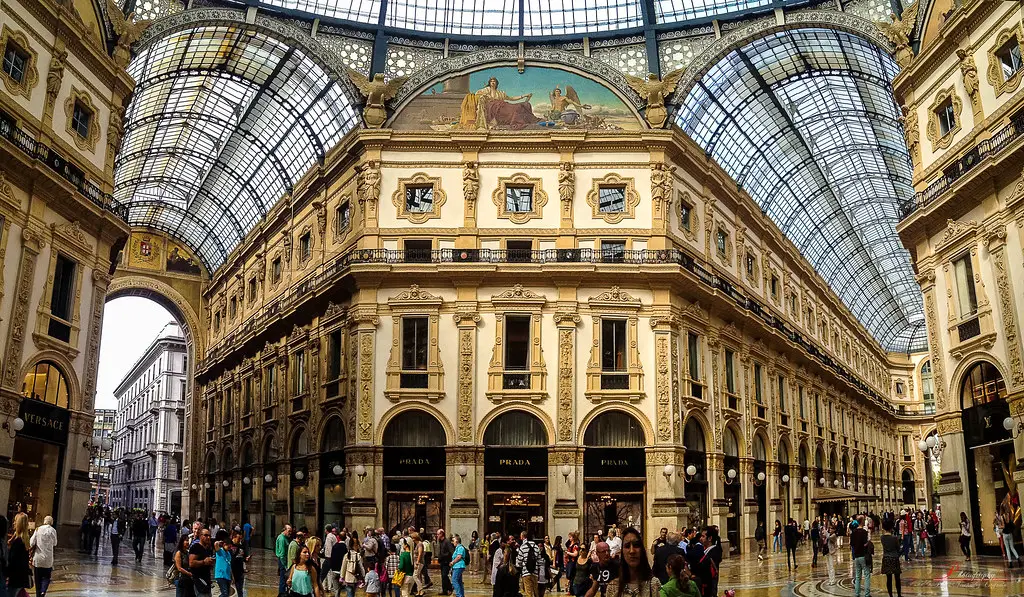
Even to this day, Galleria Vittorio Emanuele II is often referred to as the “city’s living room”, a must-stop for anyone looking for some high-quality sightseeing, shopping, or fine dining experiences. The architectural beauty of the gallery, with its glass dome on the roof and intricate mosaics on the pavement, continues to attract tourists from all over the world. It has also become a popular spot for fashion events and exhibitions, further cementing its status as a hub for style and luxury in Milan.
See the Last Supper
At a time in history, Milan was home to one of the world’s most renowned artists. Among them is the painter, inventor, scientist, sculptor, and architect named Leonardo da Vinci. Much of his work still resides in Milan, and the city is the home of one of his most famous paintings worldwide, The Last Supper. At the end of the 15th century, Da Vinci painted the last dinner between Jesus and his disciples on a commission from Ludovico Sforza, his employer, for nearly two decades. The painting is 4.6 meters high and 8.8 meters wide and is located in the refectory of the ancient convent attached to the church.
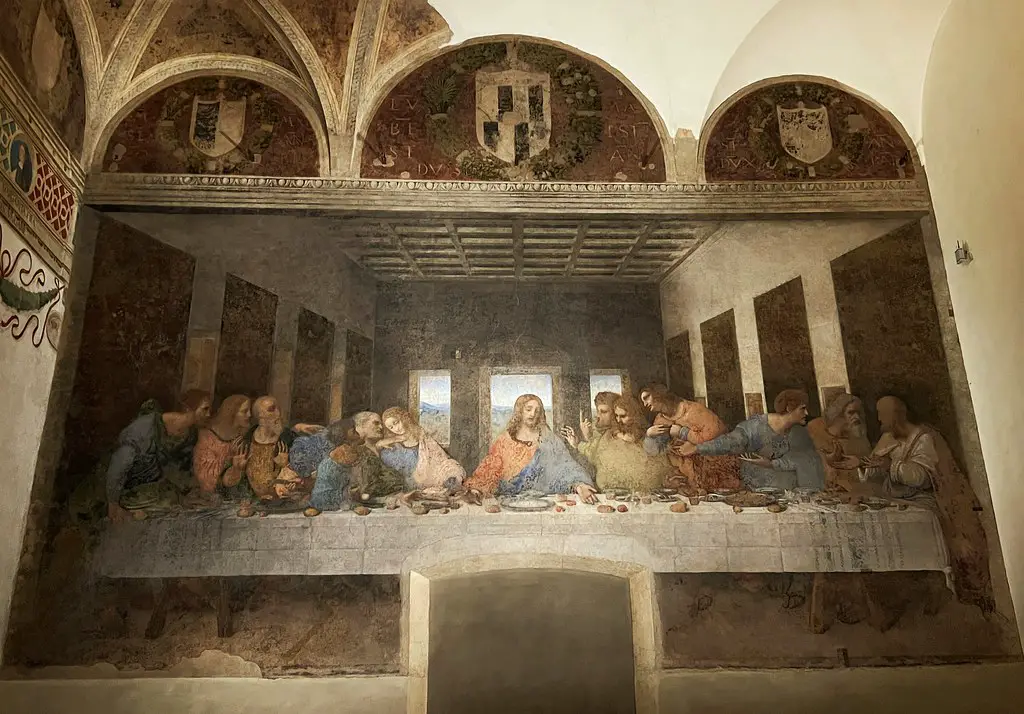
The Last Supper is known for its intricate details and composition, showcasing Da Vinci’s mastery of perspective and human anatomy. The painting has undergone extensive restoration efforts to preserve its beauty, making it a must-see for art enthusiasts and history buffs. Just a 20-minute’ walk from Duomo is Santa Maria delle Grazie, a church that is the home of this work of art and allows you to visit this marvelous piece. If you are ever in Milan, don’t miss this unique opportunity to see one of the most renowned paintings in the world. The visitations are from Tuesday to Sunday, so make sure to plan your trip so that you can see this art jewel in person!
Visit Sforzesco Castle
Just outside the historical city center and Duomo proudly stands the Sforzesco castle. Originally a medieval fortress, the current castle was built on top of it in the 15th century. It had many Italian and foreign rulers residing within its walls. The Sforzas, a prominent Milanese family whose member Francesco commissioned the castle while he was lord of the city, were one of them. Napoleon Bonaparte and other foreign invaders also used the castle during their conquests. However, it was this turbulent military history of the castle that made Italians rethink its purpose.
They repurposed the castle to become the seat of the Modern Art Gallery, and the gallery was there until 1920. It was also combined with the School of Applied Engineering Art, which was there slightly longer until 1999. In recent years, the Italians decided to keep the castle’s art heritage and installed an art gallery on its premises, so to this day, you can see exhibitions from the most influential Italian artists at the castle. It also offers a variety of activities and hosts numerous events, allowing Sforza Castle to continue to be an important aspect of Milanese culture, but in a more peaceful and beauty-oriented way.
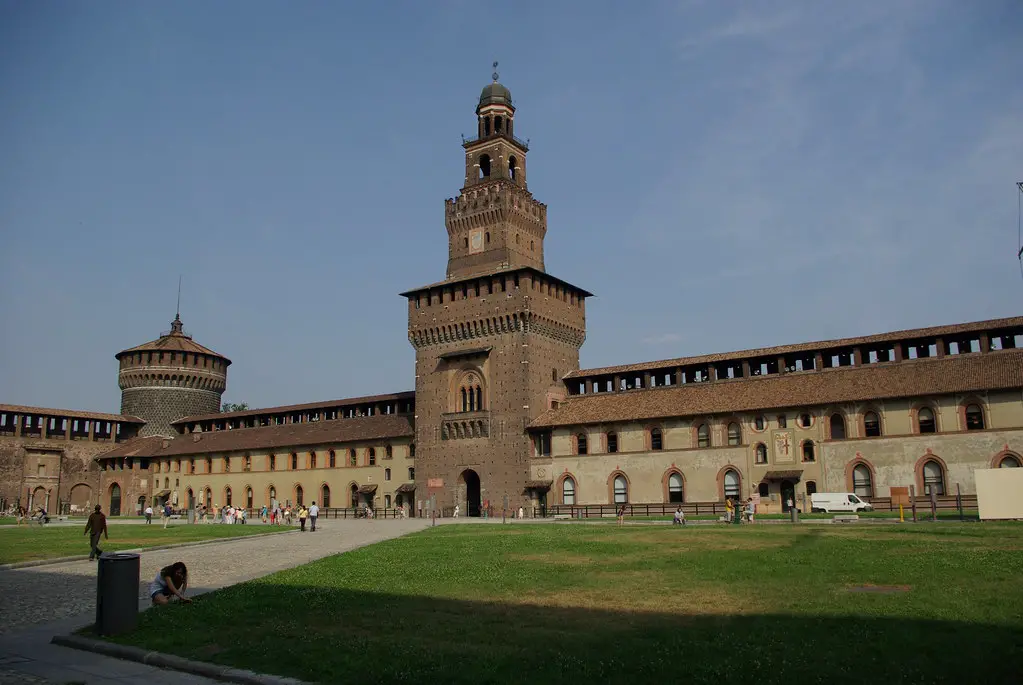
If you decide to visit the castle, don’t miss the Pietà Rondanini, the last work of the renowned Michelangelo. Michelangelo worked on it until his very last day, yet the sculpture, almost two meters tall, was never finished due to his death in 1564. Some say the sculpture is finished and that it is up to you to imagine its end form—you won’t know until you visit!
Live show in La Scala
La Scala is one of the most prominent opera houses in the world, and you should certainly not miss the opportunity to see any live shows in it while on your visit to Milan. Some of the most famous opera singers, both Italian and foreign, have appeared on its stages. And if you prefer to watch rather than listen, it is good to know that it is also considered to be one of the leading ballet theaters in the world!
La Scala is home to La Scala Theatre Ballet, La Scala Theater Orchestra, La Scala Theatre Chorus, and the Filarmonica della Scala Orchestra. The opera house also has La Scala Theatre Academy, which offers professional training in the arts that many aspire to perform on its stages. Each year, La Scala’s season starts on the feast day of Saint Ambrose’s Day, the patron saint of Milan, on December 7.
Gallerie d’Italia
Art lovers who are staying for 5 days in Milan should not miss a visit to the Gallerie d’Italia. This museum and cultural complex is part of four complexes; the other three are located in the centers of Naples, Turin, and Vicenza. The whole idea started when Intesa Sanpaolo, the leading banking group in Italy, decided to share more than 35 thousand artworks it has in its heritage with the public. Today, Gallerie d’Italia museums host both permanent and temporary exhibitions from this collection and other museums around the country.
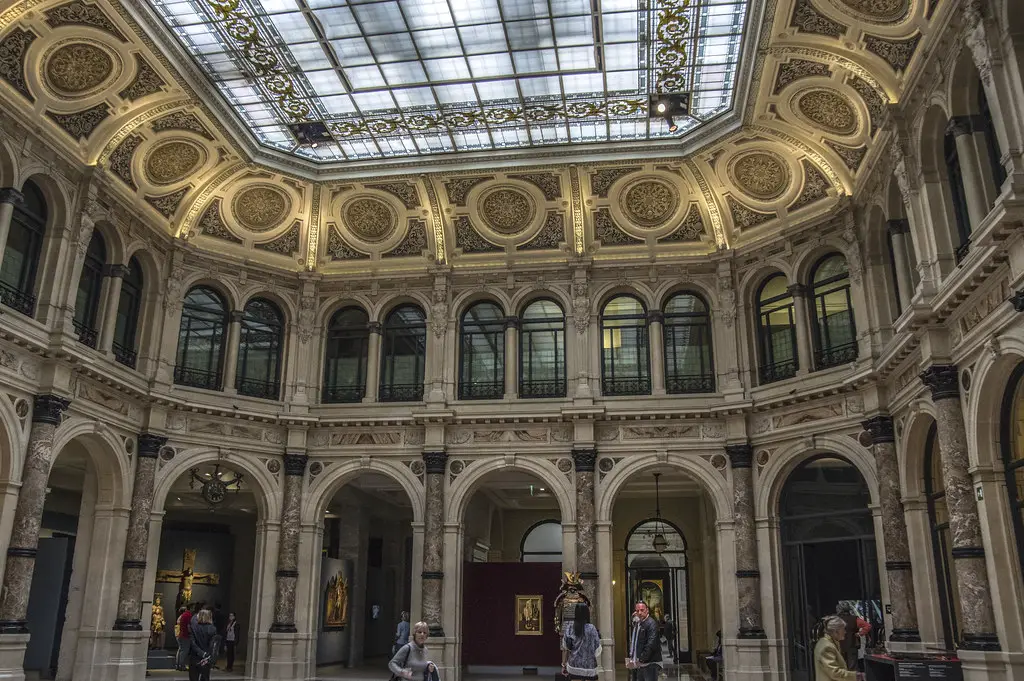
The exhibitions are often paired with wonderful and exciting events and activities. The latter revolves around cultural activities and includes book launches, educational programs, music, and theater workshops. The gallery in Milan is huge and is certainly worth spending a day here, as visitors can immerse themselves in a diverse variety of styles and mediums, from contemporary paintings to classical sculptures.
It constitutes approximately 8300 square meters of art, beauty, and architecture, as exhibitions usually take place along the paths that connect Piazza della Scala, Via Manzoni, and Vina Morone. The gallery’s splendor is complemented by stunning architectural designs, showcasing the perfect blend of historical elegance and modern aesthetics that Milan is famous for.
Explore the Brera neighborhood
Once you have completed exploring the historical center of Milan, you might want to jump into a more urban scene. While set in beautiful 18th-century buildings and cobbled streets, the Brera neighborhood is the vibrant home to emerging designers, paired with original stores selling handmade cosmetics and other handcrafted goods.
It is the perfect place to shop and relax while you are on your tour of the city, as the cozy, chic, yet elegant atmosphere, paired with cafes, galleries, concert halls, and shops of up-and-coming fashion designers, creates a remarkable experience as it all comes together splendidly. This lovely neighborhood is a great stop from your visit to the Sforza Castle and the perfect interlude for Quadrilatero d’Oro, which is famous for being home to some of the most reputable fashion houses in Milan!
Pinacoteca di Brera
It would be a shame now if we took you away from history and art merely to do some shopping, even though the craftsmanship you will see in Brera’s shop is nothing short of art in itself. Still, there is more to Brera than that, and one of the most important cultural aspects of Brera is the Pinacoteca di Brera. This amazing art gallery is home to an exceptional collection of Italian art. In its collection, you will be able to find works from some of the most renowned artists, such as Caravaggio, Rafael, Piero della Francesca, and Tintoretto.
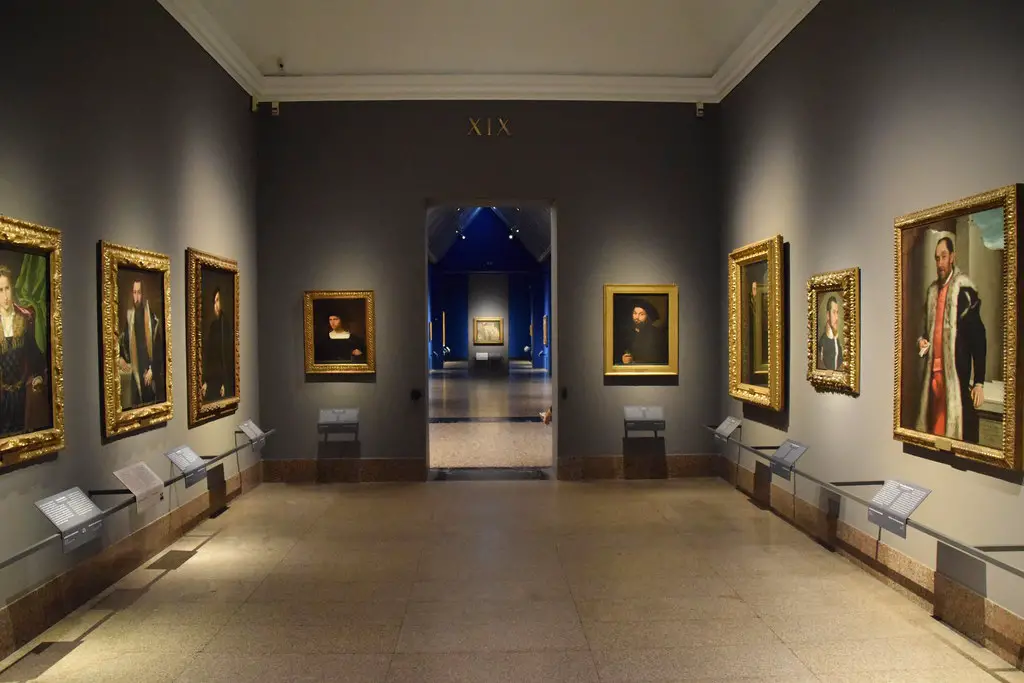
Now, it wouldn’t do much for this exceptional gallery to be Italian-only. Luckily, it often displays international artists, including Rubens, Van Dyck, and Rembrandt. Just like the whole city of Milan, the gallery also combines gorgeous architecture with works of art, so all the paintings from the collection are displayed in a beautiful building that radiates class and elegance.
Brera Botanical Garden
Brera is where you will also find the exquisite historical botanical garden, certainly a memorable experience in itself. Tucked in behind the walls of Palazzo Brera, you will find, on paper, a museum, but in reality, a beautiful green break from city life. The garden has been there for quite some time, and it still maintains its original layout, set up in the 14th century!
Yet, it was not until the Empress Maria Theresa of Austria designated the garden as the Botanical Garden of Brera in the 18th century. Ever since the place has been used to teach botany and pharmacy through the use of the medicinal species growing in the garden. The garden became a part of the University of Milan in 1935. The university still manages the garden and maintains its two elliptical ponds, narrow flowerbeds, and arboretum.
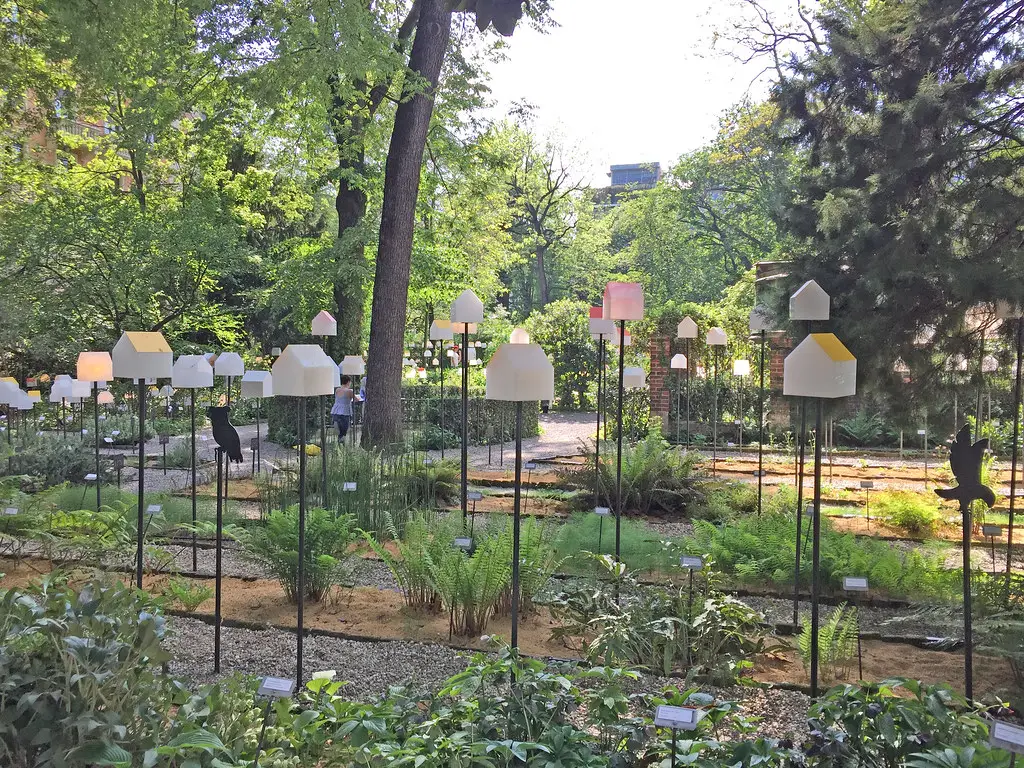
The flowerbeds include some of the most magnificent specimens of Paeonia and Hydrangea, as well as the thematic collections—plants used for medicinal purposes, for dyeing, making paper, etc. You don’t have to plan your visit here, either! The garden is open throughout the year and offers something breathtaking for every season, so don’t forget to stop by while in Brera.
Shopping in Brera
There is no shortage of shopping spots in Milan, and the city plays an important role in crafting the fashion trends of today. The Fashion District, which is spread across four streets named Via Montenapoleone, Via della Spiga, Via Sant’Andrea, and Via Manzoni, offers an excellent shopping opportunity to grab pieces from some of the most famous Italian designers, including Versace and Gucci.
Still, not everyone is looking to buy brands. If you are looking for something unique, handmade, and never seen before outside of Milan’s Fashion Week, Brera is the district to go shopping. As we have mentioned before, it is a place where all the up-and-coming designers have their shops, and you can also purchase other handmade goods that come with premium quality, excellent design, and with a much more affordable price tag.
Read more: Shopping in Brera neighborhood guide
Relax in Sempione Park
After a long day of sightseeing in Milan, Sempione Park is a local oasis to take a break, relax, enjoy nature, and feel like a part of Emily Bronte’s novel. Located in the middle of Milan, with beautiful Castello Sforzesco and Arco della Pace just a couple of minutes away, it is the perfect spot to unwind, especially in the summer, for both Italians and tourists. The beautiful Sempione Park used to be a forest, with the Sforza family keeping numerous exotic animals there.
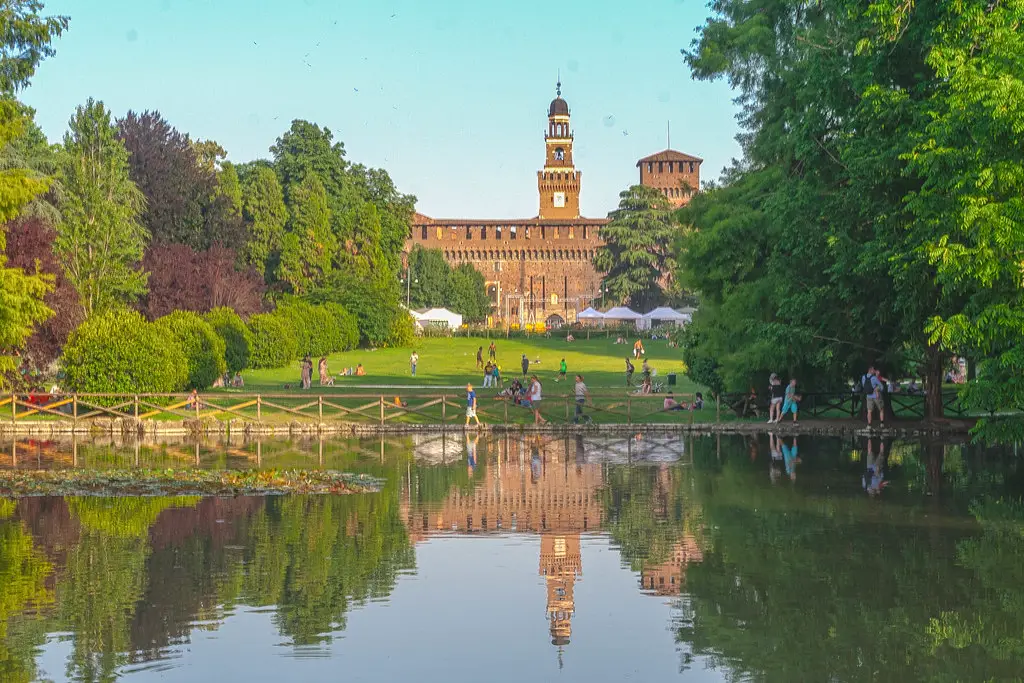
Later, it was used by the military residing in the Sforzesco castle. The current park was built in 1890 and is inspired by 19th-century English gardens. Here, you will find a small artificial lake which is the gathering spot for ducks. There is a small wooden bridge you can use to cross it, which is decorated by numerous padlocks locked there by many happy couples. You will also find coffee shops and kiosks with terraces if you need refreshments, plus there is also free WiFi, for those who work “from home” or would like to upload photos of this beautiful park on Instagram.
Arco della Pace
If you saw a postcard of Milan with the Arco della Pace monument on it, you might, for a second, mistake it for the Arc du Triomphe in Paris! You wouldn’t be far away from it though, as both monuments were commissioned by Napoleon Bonaparte! Under his orders, the work on Arco della Pace started in 1806 to celebrate his victories to that date.
Bonaparte commissioned Italian architect Luigi Cagnola, who drew inspiration from Roman arches and dedicated the work to the Roman goddess Victoria. However, nine years later, Napoleon suffers a defeat at Waterloo, and work on Arco della Pace comes to a stop. It was resumed eleven years later under Austrian rule as a tribute to peace, and it was finally opened in 1838.
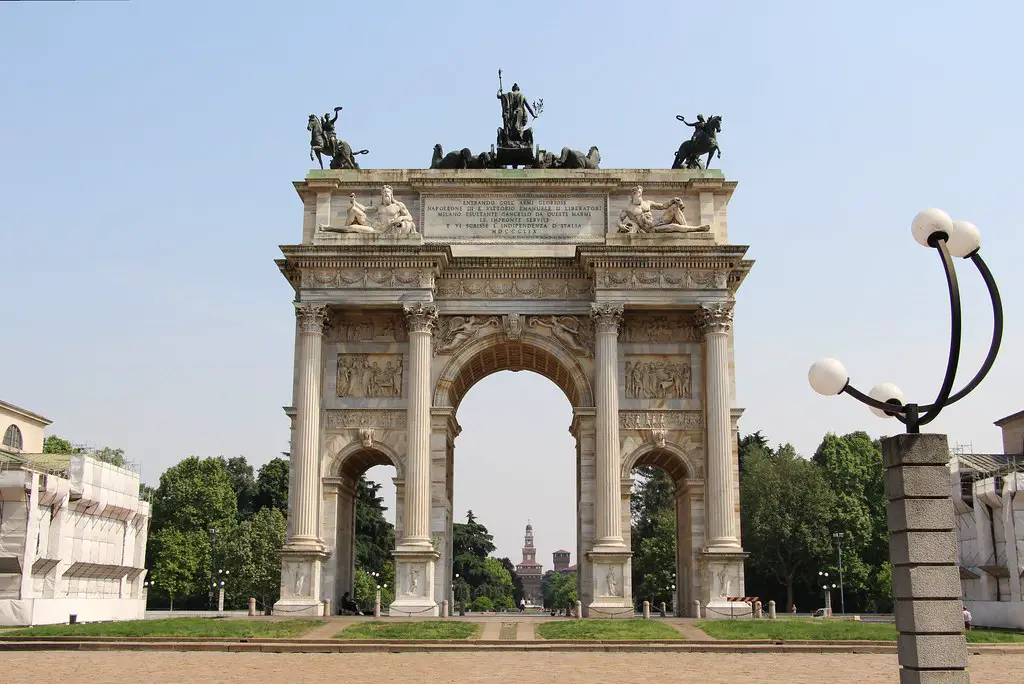
Now, this arch is nothing short than a beautiful work of art, and if you decide to explore it, you will notice depictions of both Roman mythology, such as representations of Mars, but also famous events such as the battle of Leipzig – even the Congress of Vienna. On top, you will find beautiful sculptures of the goddess of peace, Minerva, riding a chariot pulled by six horses, and you can also see inscriptions celebrating Italian soldiers who died in the First and Second World Wars.
Torre Branca
While at Sempione Park, you should not miss the opportunity to see the beautiful view of Milan from above. The way to do this is by taking a one-minute elevator ride at Torre Branca to reach the highest point in Milan at 108.6 meters high and enjoy the unobstructed view of the whole city. The Branca Tower was built in 1930 and is in itself a work of art in modern architecture. It was designed by Gio Ponti and was up and running in a mere two and a half months! Standing in front of this elegant, slim, and transparent tower, planned to not obstruct the beauty of the park, it is truly an architectural marvel!
Unique experience at ATMosfera restaurant
Probably the best dining experience in Milan is the restaurant ATMosfera, which we can’t praise enough. It is a unique dining experience, and it combines beautiful Milan at night, some of the most delicious food, and great wine, all set in a tram styled after “Orient Express”! Ride through Milan while savoring traditional and delicious meat, fish, or vegetarian dishes prepared for you by some of the best chefs in the city in a very atmospheric environment.
It is perfect for business lunches with partners you are looking to impress or for achieving the same results on your dinner date! There are two ATMosfera trams, which are open seven days a week, and you can enjoy them year-round. Keep in mind, though, that to experience this, you need to make reservations in advance, so make sure not to forget to book it before visiting Milan, as it will certainly be one of the most memorable eating-out experiences of your life.
Monumental cemetery
Now, we understand it’s not common to recommend a visit to the cemetery. Still, the Monumental cemetery in Milan is much more than that, and you should definitely visit it. “Why would I want to visit a cemetery?” you might wonder. Well, this one is often described as an open-air museum, as it has the artistic standard for mausoleums! Yes, each has to be approved by a special committee before it is built to maintain the cemetery’s surprisingly beautiful atmosphere.
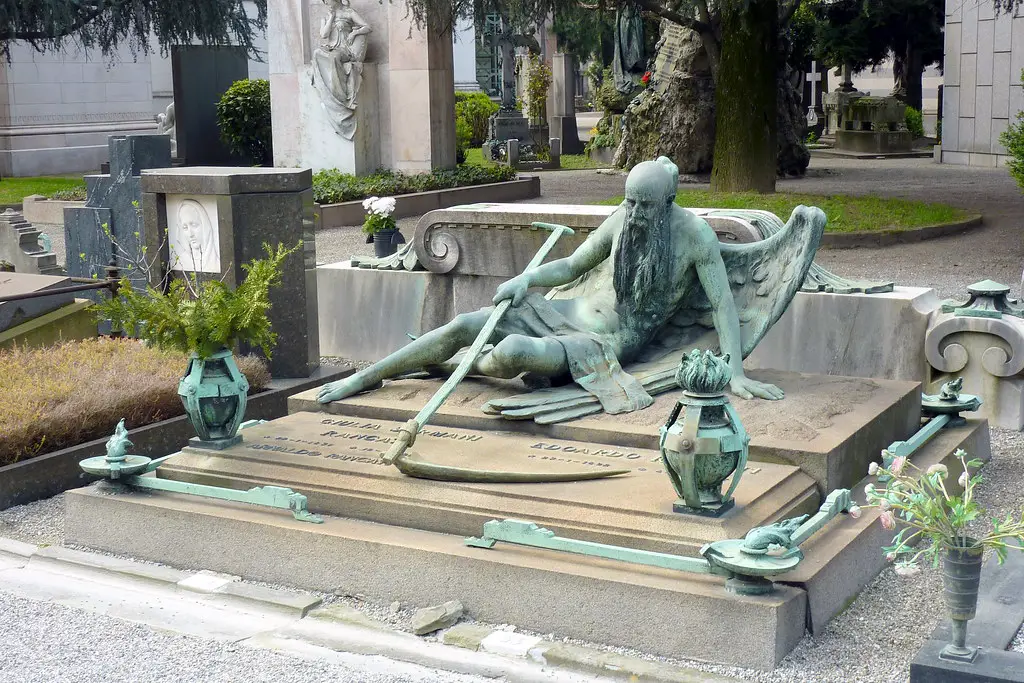
Somewhat morbidly, this cemetery has been the place to be buried since it opened in 1866, and it is where some of the most remarkable people from Milanese society are resting in peace. Where other cemeteries are there just for burials, Milan’s was created for visits, with its beautiful angel statues, reproductions of the Last Supper in bronze, and even monuments in the darkest neo-gothic style with skulls and scary figures.
Admire churches in Milan
It is no secret that Italians are religious people, and have been so for centuries. The testament of their great faith can be seen in numerous churches and cathedrals, with some of the most remarkable ones located right in the city of Milan! So, even if you are not religious, you should add these to your itinerary. Not only can you admire the history hidden in these beautiful walls, but also enjoy art and frescoes, as well as some of the most beautiful colored glass windows you have ever seen. Here are just a few of Milan’s churches you could pay a visit to.
Chiesa di San Maurizio al Monastero Maggiore
The church nested in the center of Milan, Chiesa di San Maurizio al Monastero Maggiore, might not impress you much from the outside, especially if you have just visited the Milan Cathedral. Still, don’t let that deter you from going inside, as this church is nicknamed “The Sistine Chapel of Milan” for a good reason. Once inside, you will be greeted with an explosion of color, as every inch of this gorgeous little church is covered with either paintings, frescoes, or mosaics. The colored stained glass windows at the church are works of art as well! This pleasant surprise will leave you astonished, and considering its closeness to the city center, it is well worth a stop-by at least.
Santa Maria delle Grazie
If you already calculated seeing DaVinci’s Last Supper into your itinerary, then you have already planned a visit to Santa Maria delle Grazie which hosts this beautiful art. The church of Santa Maria delle Grazie was finished in 1482, and its fourteen chapels were used by prominent Milanese families for private prayer as well as a place of burial. Apart from The Last Supper, the church also houses the important frescoes of “Stories of Life and the Passion of Christ”. It was also the home of Titian’s The Coronation of Thorns, but the painting now hangs in the Louvre.
Basilica di Sant’Ambrogio
One of the oldest churches in Milan, The Basilica di Sant’Ambrogio, is traditionally considered the second most important religious building in Milan, with the first being Milan Cathedral. It is regarded as the work of the city’s patron, Saint Ambrose himself together with three other churches. The church was built between 379 and 386, in the late Imperial Roman era. It was then rebuilt in 1088, and the current church that you can visit was finished at the beginning of the 12th century.
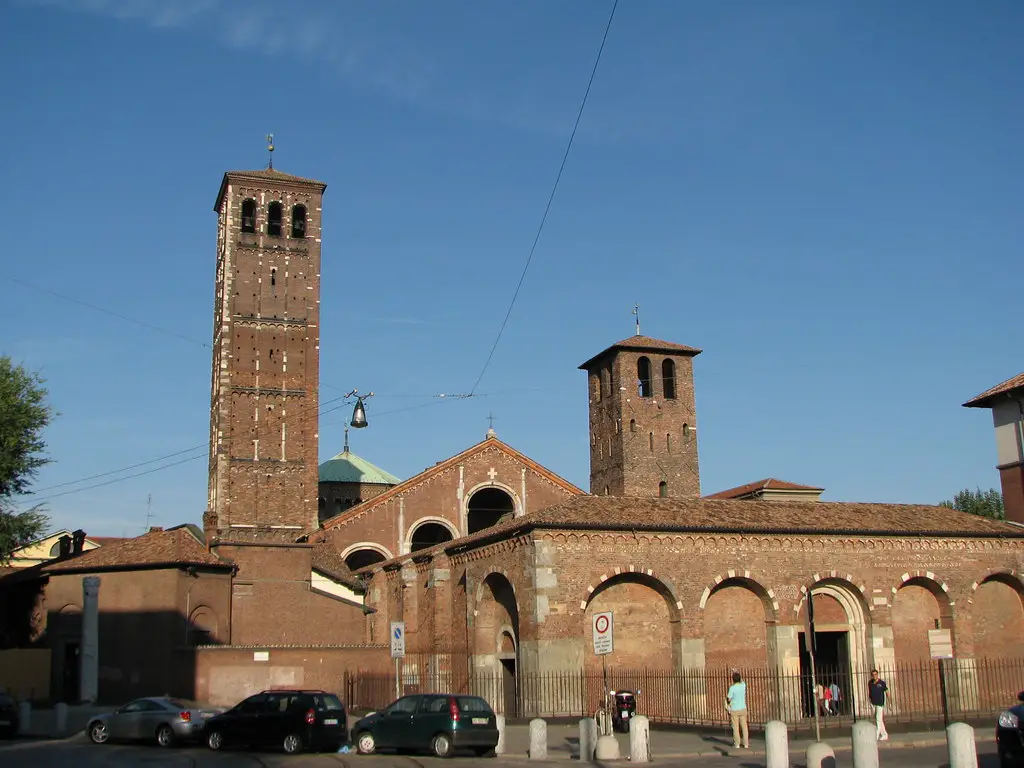
Saint Ambrose was buried in the church, along with many other martyrs of the time. Inside the church, you will find beautiful frescoes, mosaics, and sculptures depicting Jesus and his apostles, as well as notable saints. The dome from the 5th century is particularly beautiful, covered with golden mosaics and a representation of San Vittore in its center. You should also try to see a goldsmith masterpiece of the Middle Ages, which is the Altar of Sant’Ambrogio. It is entirely covered in precious stones, gold, and silver, and has once covered the relics of the saints Ambrose, Gervasius, and Protasius.
When visiting this church, take your time to admire the beautiful sarcophagus of Stilicho. It was created in the second half of the 4th century. The early craftsmanship that has created the beautiful representation of Christ and his apostles on the sarcophagus sides is truly a sight to remember.
Chiesa di Santa Maria presso San Satiro
An architectural marvel and home to a miraculous icon, the Church of San Satiro was built in the 9th century and was dedicated to Sant’Ambrogio’s brother, San Satiro, whose name it still carries today. In the second half of the 15th century, Chiesa di Santa Maria presso was built to accommodate the icon: Painting of the Madonna and Child by Giovanni Bellini.
However, the architect, Donato Bramante, was unfortunately quite limited in terms of the space designed to build the church. Still, he had no intention of creating something that was less than awe-inspiring, leading to the memorable illusionistic creation that we can see and experience today. The apse, in which the image of the Madonna is kept, is a mere 97 centimeters in depth, yet what Donato Bramante achieved with his mastery of perspective was to create an illusion of the apse that is 9.70 meters deep!
Explore museums in Milan
Luckily for everyone visiting Milano, Italians are very good at preserving history in terms of art, music, and science, so you won’t find yourself struggling to find a good museum to dive into the past. Milan is quite rich in museums, and you will be able to find museums that hold private collections, church museums, and even corporate foundations—all of them working together to bring the rich history of Milan to the eyes of the public. It is hard to recommend just a few, though, but here are several museums you should visit on your trip to Milan, as each has an amazing collection of breathtaking art from different eras of Milano’s history,
Museo del Novecento
For more contemporary art, The Museo del Novecento is a perfect choice. Established in 2010, the museum’s main goal is to showcase the 20th-century art of Italy, preserve it, and promote its beauty and value. With over four thousand works in its collection, it tells the story of several smaller, private collections merged into one and its growth thanks to gifts from artists themselves, collectors, and other sources. You can easily reach the Museo del Novecento as it is located near Piazza del Duomo. You might want to schedule a visit here after you have seen the Duomo itself – it will certainly help bring you back to modern life.
Pinacoteca Ambrosiana
In 1607, Cardinal Federico Borromeo, a famous Milanese humanist, established the Biblioteca Ambrosiana, naming it after the patron saint of Milan. The Cardinal intended the library to offer free education for all, probably not knowing that he was creating something that is today considered to be one of the oldest libraries in Europe. Today, it contains more than one million volumes, paired together with rare items, prints, and drawings. The Cardinal, several years later, decided to donate his personal collection of more than 250 drawings, paintings, and statues to the library, establishing the Pinacoteca Ambrosiana.
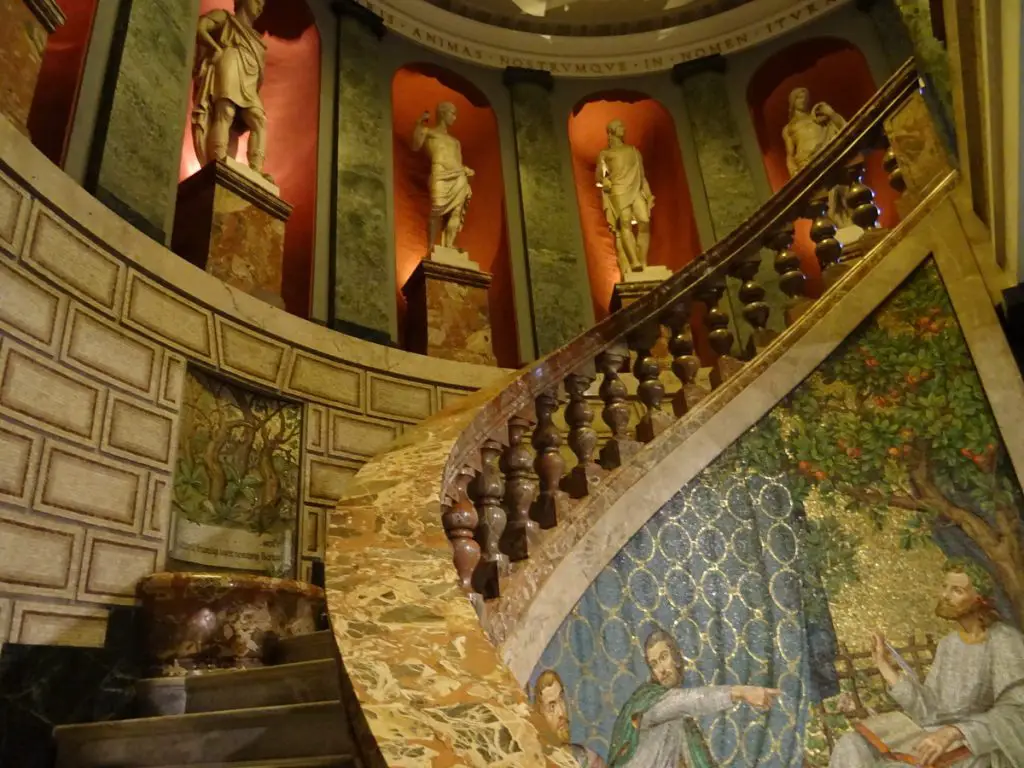
The museum grew over the years, and today it consists of 24 rooms that display some of the greatest masterpieces of all time. It is the perfect place to visit if you would like to enjoy the works of Leonardo da Vinci, Caravaggio, Raphael, Titian, and other Renaissance artists. Furthermore, the museum also has exceptional collections of 17th, 19th, and 20th-century Italian artists and painters, including Morazzone, Daniele Crespi, Francesco Londonio, Francesco Hayez, and Emilio Longoni. Considering that Pinacoteca was a place of education, you will also find numerous copies of famous art here.
These were encouraged by the Cardinal himself, as an excellent way for students to hone their skills. The items on display in the Library and Pinacoteca Ambrosiana are truly awe-inspiring. Here, you will find Da Vinci’s famous Codex Atlanticus, and see the incredible ideas written in his own hand. You will also see the gloves Napoleon wore at Waterloo and a lock of Lucrezia Borgia’s hair. The lock has inspired many artists and famous poets, including Lord Byron!
Poldi Pezzoli Museum
A bit of a hidden gem of Milan, the Poldi Pezzoli Museum is an exquisite art gallery near the Milan Cathedral. Named after Gian Giacomo Poldi Pezzoli, who was an Italian aristocrat and art collector, this museum houses the art of some of the most notable Italian artists, including Michelangelo, Raphael, Botticelli, Bellini, and many others.
Here, you will also find beautiful furniture from the Renaissance and other keepsakes beautifully displayed. If you decide to visit this museum, don’t miss the room of clocks, the space dedicated to Dante, or the Golden Room, which not only houses some of the most remarkable pieces but offers an insight into the beautiful garden of this lovely 17th-century palace in the heart of Milan.
Leonardo da Vinci Museum of Science and Technology
One of the most famous Milanese residents was certainly Leonardo da Vinci, so it is not surprising that Milanese people dedicated to him a huge museum that proudly bears his name. The very popular tourist spot, Leonardo da Vinci Museum of Science and Technology is located inside a former monastery from the 16th century and displays models based on his revolutionary inventions.
Here, you will be able to see models ranging from measuring instruments to war machines based on Vinci’s drawings and notes. Keep in mind that the part of the museum dedicated to Leonardo da Vinci is just a small part of this grand museum. Its other floors display topical exhibitions such as transport, communications, space, and many others!
If you were wondering if you should have visited Venice instead, plan to visit the Navigli neighborhood in Milan for the similar, truly Italian, atmosphere. This neighborhood on the banks of several canals running through the area is the perfect backdrop to a bohemian day, filled with beautiful walks, plenty of bookshops, excellent coffee and food, and a great shopping experience! Plus, the place only gets livelier in the evening, as it is where all the best nightlife is. The best way to explore Navigli during the day, apart from a nice stroll, is the boat ride on Naviglio Grande.
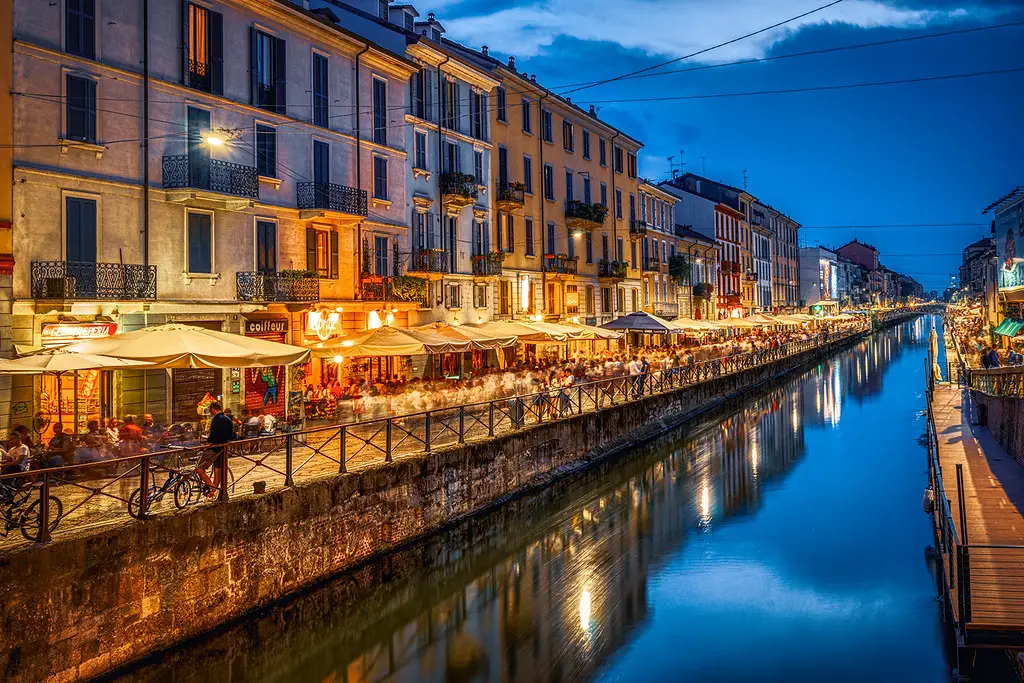
The boat ride will take you right by some of the most beautiful buildings the area has to offer, and it lasts for about an hour. You can also enjoy lunch on some of these boats! Furthermore, if you are in Milan on the last Sunday of the month, you should visit the Mercatore Antiquario di Navigli, a vintage market with over 400 stalls that sell many second-hand hidden treasures!
Check out the trendy Isola neighborhood
If you are not up for either modern or historical – pop and hipster might be your thing. If that is the case, we can highly recommend checking out the Isola neighborhood. Young, artsy, and above all, unconventional, this neighborhood boasts the best vibe in the city, plus some astonishing graffiti art. Isola also has numerous specialty stores where you can shop for everything “alternative”. There is also an excellent selection of artisanal coffee shops, restaurants, and ice cream shops!
Bosco Verticale
We have already recommended a beautiful horizontal garden to visit in Milan, so it is time to introduce a different type – a vertical one! A somewhat different type of garden, Bosco Verticale is, in fact, two buildings, opened in 2014. Both buildings are covered with plants that would, if placed horizontally, cover a garden 20,000 square meters! There are approximately 800 trees, more than 4,500 shrubs, and 15,000 flowering plants covering the facades of these two buildings, steering Milan’s skyline toward a more greener and sustainable course.
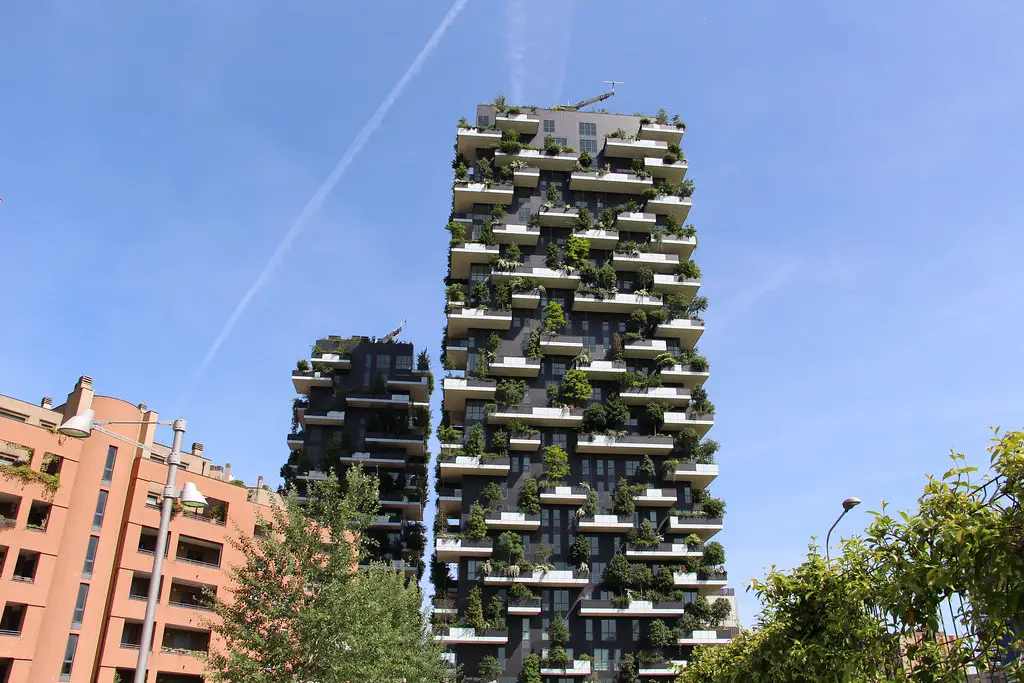
Just a month after the opening of these residential buildings, they started collecting their accolades. Most notably, the United Nations used them as an example of a sustainable urban development model, which was replicated in China! These buildings are truly a memorable sight, and you should take the time to visit the Isola neighborhood and take a look at a greener future.
Eat dumplings in the Chinatown neighborhood
A bit unconventional type of food to recommend when you are in Italy, yet Milan has an interesting Chinatown neighborhood that might be worth a visit if you need a change from pasta and pizza. Not as grand as the Chinatown available in New York, Milanese Chinatown is still the perfect place to shop for some excellent jewelry, delicious noodles, and dumplings, or other Asian groceries. Interestingly, this is also the place where you can buy some of the most delicious Italian pasta as well!
Stadium and Museum San Siro
It would be unfair to write about Milan and not mention the two biggest football teams in Europe: Inter Milan and AC Milan! Surprisingly enough, considering how deep-rooted the love Italians have for soccer, the two share the same stadium. One group of Milanese fans calls it the San Siro; the other calls it by its official name, Giuseppe Meazza; the name they are using for the stadium is a dead giveaway of which team they are supporting. San Siro is much more than a stadium. This 85,000-seater is also an architectural marvel, with its very avant-garde roof.
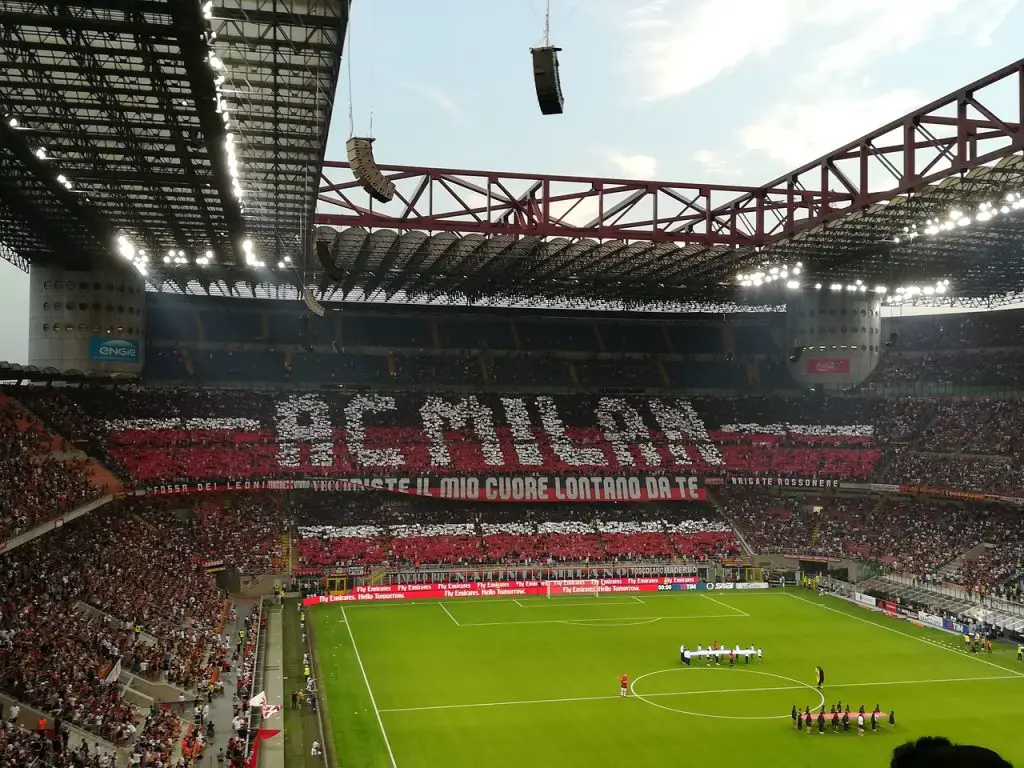
Most notably, the stadium hosted the 1990 FIFA World Cup, but it is also often filled with renowned musicians having concerts here. It was visited by U2, Bruce Springsteen, and Bob Marley! If you decide to feel a love for football, the tour of the San Siro Stadium often begins with a tour of its museum. The museum holds the memorabilia and various kits from both teams and displays mementos of various sports events. Overall, any sports lover must drop by this place while in Milan!
Day trips
Even though five days might not be enough to fully experience Milan, you might want to take a day out of your trip and visit one of these beauties in its vicinity! Alternatively, consider extending your visit to take a trip to one of these astonishing locations nearby; they are certainly worth it! Here are a couple of recommendations on what to visit nearby.
Bergamo
Of course, if you have a day to spare, you might consider heading to the city of Bergamo. Just a 48-minute drive by train from Milan, or cross the 50 kilometers that separates the two by car. Bergamo was named a World Heritage Site by UNESCO in 2017, and it is known for its charming atmosphere and historical vibe. Divided by an enormous wall, upper and lower Bergamo makes for an excellent day trip.
Make sure to start your visit at Piazza Vecchia, which stands proudly in the center of upper Bergamo and is surrounded by some of the most important buildings to visit: Basílica de Santa María, Palazzo Nuovo, one of Italy’s most important libraries, Bergamo Cathedral, and, if you can squeeze it in, the ruins of the San Vigilio Castle.
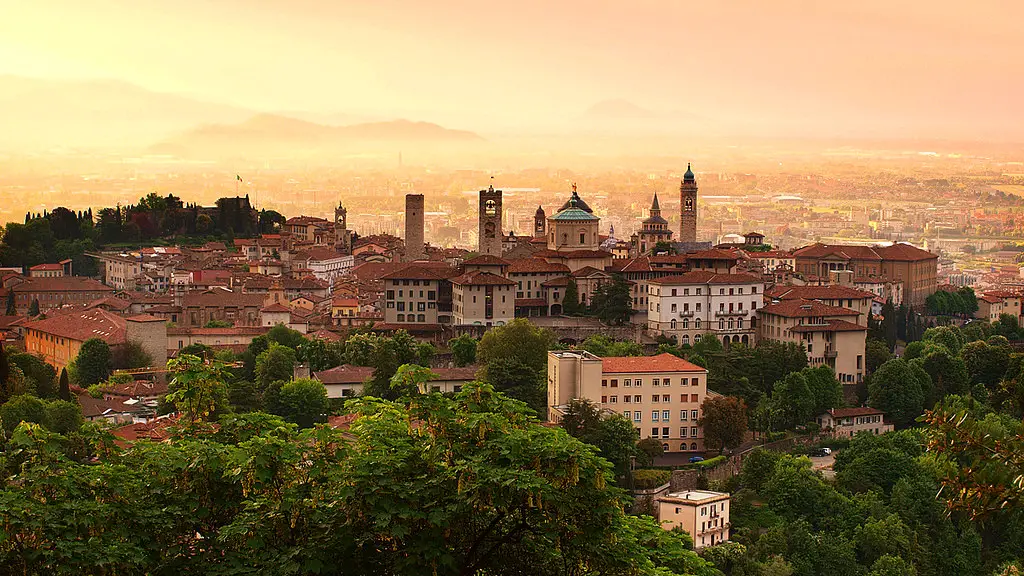
Of course, you can opt instead to enjoy a nice coffee at one of the gorgeous cafes on Piazza Vecchia before heading down to lower Bergamo. Lower Bergamo offers a more modern approach to Italy. You should take the time to visit the Accademia Carrara, the most famous museum in the whole city. Make sure not to miss the Porta Nuova district, which is where the trendy shops, bars, restaurants, and businesses are.
Lake Como
Lake Como, one of the most beautiful spots in all of Italy that needs no introduction, is just an hour away from Milan. This beautiful, Y-shaped lake, surrounded by mountains, has attracted both tourists and artists for years. Apart from the beauty of the lake itself, you should certainly visit some of the lakeside gems, including the city of Como, known for its charming historic center and stunning cathedral.
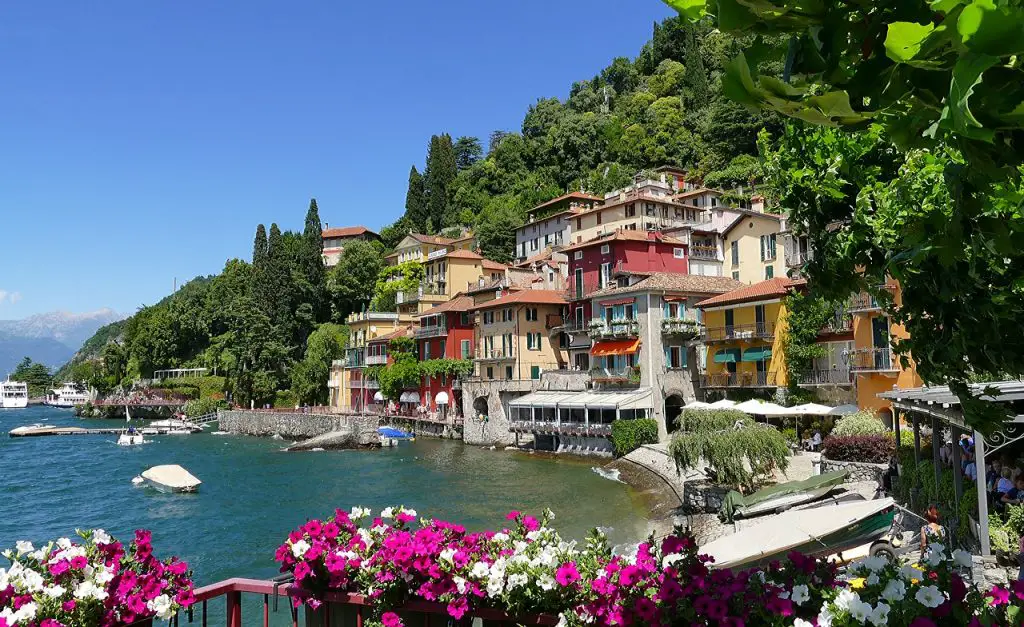
Another must-see is the picturesque village of Bellagio, often referred to as the “Pearl of Lake Como,” with its narrow streets, colorful houses, and breathtaking views. Lake Como today is also the home of some of the most exclusive villas in the world and is the place where famous people love to vacation and unwind. Who knows? Maybe you’ll bump into George Clooney on your tour here!
Lake Maggiore and Borromean islands
Once you are in Milan, it would be a shame to miss the beauty of Lake Maggiore and the Borromean islands, the three islets that embellish this beautiful lake. This second-largest lake in Italy stretches over two provinces and two countries; about 20% of the lake belongs to Switzerland. Like other lakes in Italy, the tranquility of the lake, paired with the beautiful villages on its coasts, makes it a favorite vacation place.
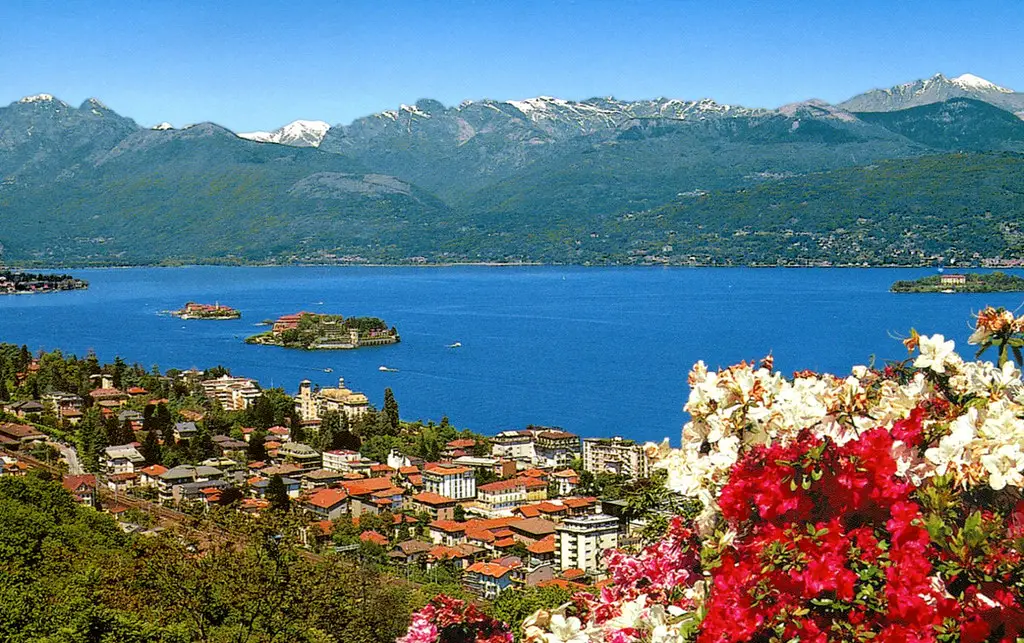
Angera is one of the largest towns on the lakeside, certainly worth a visit, and you should not miss Verbania, the main town, with its beautiful botanical garden. To make sure you don’t skip on the beauties of the Maggiore Lake, you should travel around the lake, either by car or on one of the trains that run on either side of the lake. You can visit each of the three islets in the Borromean Archipelago.
Isola Bella is the most famous islet, being home to the Palazzo Borromeo, the Borromeo Palace, and its magnificent gardens. The largest, Isola Madre, is home to another palace of the Borromeo family. Its gardens have some of the tallest palm trees in Italy, and you can enjoy the diverse fauna as this is the place where pheasants and parrots meet. The third, Isola dei Pescatori, is the most humble. Approximately fifty people still live there and make up a small, seafaring community. It’s the place to stop by and eat some of the most delicious fish straight out of the lake.
Lugano in Switzerland
A memorable day trip from Milano could also be a trip to Lugano in Switzerland. Located on Lake Lugano, this city will feel like an extension of Italy itself, as the architecture, cuisine, and even the language are very Italian-esque. The city of Lugano has 17 sites that are part of a Swiss heritage site of national significance, meaning that you have a lot of sightseeing to do on your day trip!
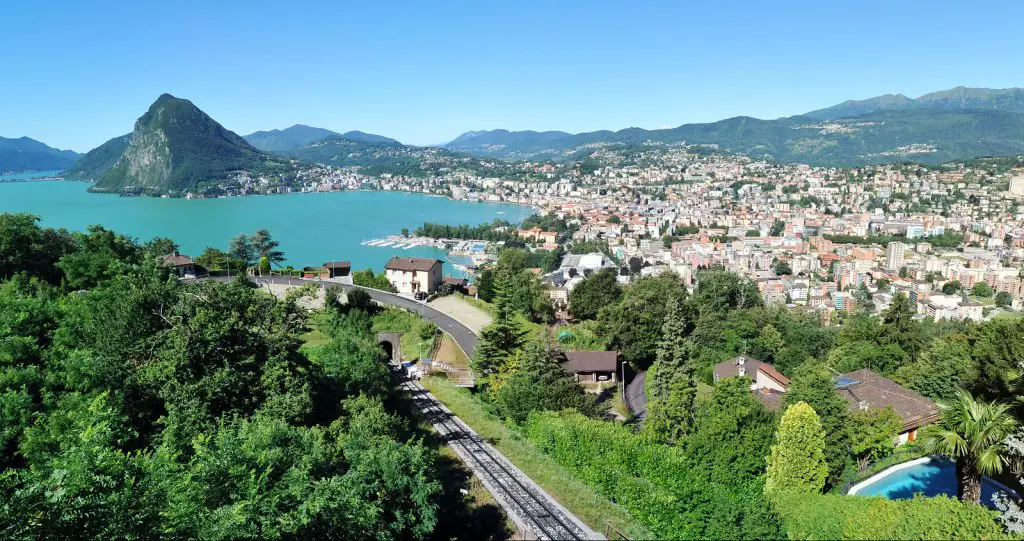
Some of the most remarkable buildings you shouldn’t miss are the Biblioteca Cantonale, Church of Santa Maria degli Angioli, and, if you have the time, Palazzo Civico or City Hall. Of course, you could also take a boat trip on the lake Lugano, or participate in outdoor activities in the surrounding mountains – the mountains are the home to famous and the largest net of mountain biking trails in Switzerland!
Go to Florence with the fastest train in Italy
If you would like to dedicate the day to visiting another remarkable Italian city, you should head on to Milan Central Station, which is an architectural marvel in itself, and catch one of the fastest trains in Italy to Florence! These trains take a mere hour and forty minutes to reach Florence, which is an extraordinary feat considering that the distance between the cities is 190 miles!
The trains will take you through some of the most breathtaking scenic views of Lombardy, Emilia-Romagna, and Tuscany. They leave once or twice per day, and each train is equipped with a cafe, a food cart, and free WiFi for a top-notch traveling experience!
Check out more articles about Milan:
- Best restaurants in Milan near Duomo
- Where to eat breakfast in Milan?
- Best restaurants in Navigli Milan
- Best Mexican restaurants in Milan
- Best Chinese restaurants in Milan
- Best Indian restaurants in Milan
- Best Kosher restaurants in Milan
- Best restaurants near Milan Malpensa airport
- Is Milan expensive to visit?
- Best 4 star hotels in Milan
- Best 3 star hotels in Milan
- Best hotels in Isola neighborhood in Milan
- Is Isola in Milan safe?
- What to do in Brera neighborhood in Milan?
- Best restaurants in Brera in Milan
- Shopping in Brera neighborhood in Milan
- Best restaurants in Chinatown in Milan
- Is Chinatown in Milan safe?

